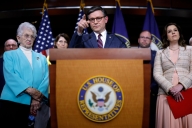You have /5 articles left.
Sign up for a free account or log in.
NEW YORK – More revenue does not seem to be in the cards for colleges and universities, as states continue to impose tight budgets on public institutions, while a fear of high tuition and borrowing limits what private institutions can charge. That was the consensus of college and university leaders gathered here, who argued that as a result they will need to focus increasingly on controlling costs.
At a conference at the New School, a group of mostly private university administrators and researchers discussed what the next 20 to 30 years would hold for higher education, focusing in particular on how institutions would manage unstable revenue sources and the growing costs of educating students.
While much of the conference was conducted cordially, it wasn’t devoid of conflict. With the conference held in the same city as Occupy Wall Street and taking place just a few days after a controversial vote by the Board of Trustees of City University of New York to increase tuition, sentiments and protesters from the Occupy Wall Street movement spilled over into the conference. Some of the actions disrupted the proceedings, such as when protesters interrupted CUNY Chancellor Matthew Goldstein by coughing throughout his speech and "Human Microphoned" a speech about rising tuition costs. But they also challenged speakers on the growth of administrative positions at universities and asked panelists how they could reconcile rising tuition prices with institutional missions of access. And those sentiments helped steer some of what the panelists addressed.
“As we look ahead and look at the incredible increases in the costs of education, at all levels, but certainly at the higher education level, we brought it on ourselves,” said Neil Grabois, dean of the New School’s Milano School for International Affairs, Management, and Urban Policy. “We brought it on in the sense that we have changed the way colleges and universities are structured. We have shifted in fact from a notion of the social good that higher education provides to the private good. We are more and more educating for jobs.”
Throughout the conference, two main strains of thought emerged from the dialogue. The first was the significant "disinvestment" in higher education that most states made over the past three years. In a survey of college presidents conducted by Inside Higher Ed earlier this year, public college and university presidents overwhelmingly listed budget shortfalls and changes in state support as the two most pressing issues facing their institutions.
“There has been a constant regression of support away from public universities by state and local government. The data are irrefutable,” said Goldstein. “When we posit the view that the world is going to be unforgiving of people who come to a university that leave or don’t leave with the kinds of skills that they’re going to need to compete in an unforgiving economy, I view this as a true national security problem for the U.S.”
Many attribute the tuition increases that the Occupy protesters were decrying here to the declines in state support. While sticker prices at all types of institutions have gone up over the past few decades, the growth has been most pronounced at public institutions, many of which have doubled tuition prices over the past decade. And while elite private institutions have increased aid to such a degree that the actual amount students pay hasn’t dramatically increased, most state universities have not.
Officials on the panel said they don’t see the trend of state disinvestment turning around over the next few years unless the tone of the conversation shifts dramatically.
“When you look at the public institutions, we’re really confronting, in my mind, a fundamental question as to how much is the public of the United States willing to support higher education as a public good,” said Robert Zimmer, president of the University of Chicago. “All these are extraordinary systems that have had a huge impact on this country … but the nature of state support for these institutions is going down considerably and those costs are being transferred to individual students and driving up debt.”
James Duderstadt, former president of the University of Michigan, said that public support for research has declined since the 1990s and that, if funding had continued to grow as it had in the past, public research universities would have about $25 billion more a year. “We think it’s appropriate that we urge the states to restore that," he said. “But there’s a snowball’s chance in hell that they’ll be able to do it for at least another generation.” As a tradeoff, he said, states should give elite public institutions more independence in decisions such as tuition to maintain their quality in the face of such declines. Several states have done that, such as Virginia, while attempts to do so in states such as Wisconsin and Oregon have backfired.
Many have already taken steps to maintain quality, regardless of whether states have given them increased latitude to do so. The revenue streams for public colleges and universities look more like those of private universities than they did in the past. Private giving, endowment support, and federal and corporate support have all grown as a share of public institutions’ revenue streams.
And more and more public institutions have tried to increase tuition to cope with state funding losses. Several major public universities, including the University of California system, now bring in more revenue through tuition dollars than state appropriations.
“We came up with a very different funding model about 2004 that has incrementally helped CUNY to become stabilized, in part because we emulated some of the practices that have been very much a part of the great private universities and some of the very strong public universities, by looking for... new funding streams,” Goldstein said. The CUNY board of trustees voted in November to increase tuition $300 a year through 2015, and the university has expanded its fund-raising efforts.
Because revenue streams have changed so significantly, and because the future of funding, and in particular state funding, is so uncertain, the second major issue that came up during the conference was how universities could begin to control the rapidly escalating cost of educating students. In 2009, public research universities spent an average of $36,190 per student per year, while private universities spent $66,744, according to the Delta Project on Postsecondary Education Costs, Accountability, and Productivity. The only sector of higher education to cut how much it spent per student was community colleges.
“Cost increase and direction is unsustainable,” said Jamshed Bharucha, president of the Cooper Union. “Universities are getting too expensive too fast. I just don’t see how that can be sustained, except perhaps by a few of the most wealthy private universities.”
The cost question is exacerbated by the significant constraint on revenues. “Costs are bearable at colleges and universities if revenues are going to be robust, but they’re not going to continue to be robust,” said Henry Bienen, former president of Northwestern University. “There’s going to be pressure everywhere.”
For many speakers, the key to controlling costs lies in technology. Vijay Kumar, director of the Massachusetts Institute of Technology’s Office of Educational Innovation and Technology, spoke about some of the initiatives going on in higher education designed to change pedagogy to drive down costs. “One of the things technology can do is change old notions of access, cost, and quality,” he said. While administrators previously assumed they could not improve institutional quality and access without incurring significant cost, that might not be true anymore, he said.
While many of the cost-savings initiatives talked about at the conference revolved around technology, panelists threw out some other ideas as well. Changing the academic calendar to make better use of university facilities, ending the arms race in student services and amenities, and rethinking how faculty members are hired and retained were all discussed as issues colleges and universities should consider when examining costs, but panelists did not delve into specifics.
Touching on the sentiments expressed by Occupy Wall Street groups, including students who spoke at the conference during the question-and-answer session, access to higher education as prices increase was something speakers tried to address.
“Access is as serious a problem today as it has been since World War II,” Bharucha said. “While many barriers have been lowered to access that might have existed in this country in previous times, such as religious barriers, racial barriers … I think socioeconomic barriers are probably more pronounced today than certainly any time I can recall.”
Bharucha’s institution, Cooper Union, which has been tuition-free for much of its history, recently announced that it would consider charging tuition as it looks to replace its unsustainable financial model.
Low tuition prices, the panelists argued, are only one potential solution to the access question. Higher education, panelists said, is one of the only industries where the price of a service does not accurately reflect what it costs to produce it.
Several of the speakers brought up the idea that college and university presidents should follow a play out of the private-university playbook by employing a high-tuition, high-aid model. Under such a model, institutions would charge higher tuition and use revenues from individuals who can afford to pay more to supplement those who cannot.
No matter how colleges and universities went about transitioning to new cost and revenue structures, several panelists stressed the importance of doing so deliberately with an eye toward maintaining quality, or the transition could end up costing more than anticipated. “It’s infinitely harder to rebuild greatness once it has been dismantled than to maintain it as it is,” said Jonathan R. Cole, former provost of Columbia University.








